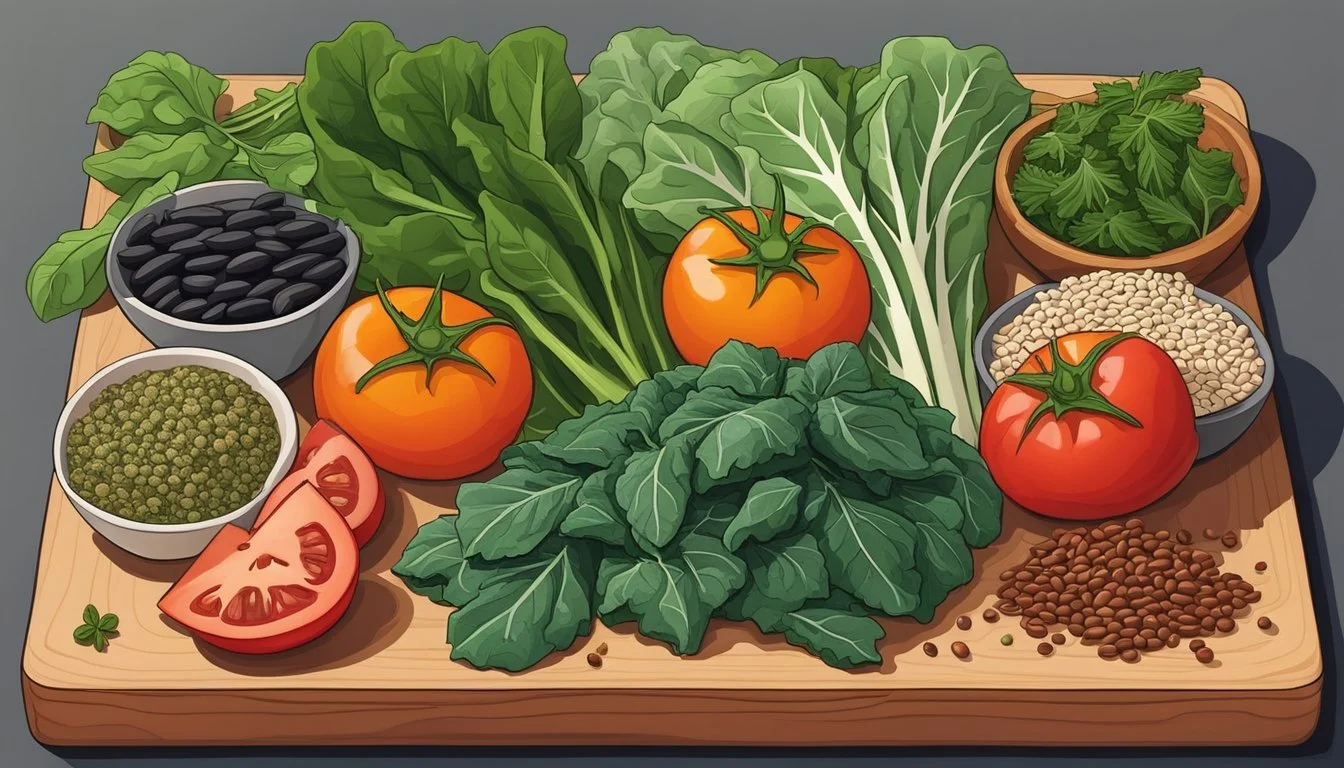8 Delicious Diabetes-Friendly Recipes Using Collard Greens
Nutritious and Flavorful Meals
Collard greens are a powerhouse of nutrients and a staple in many kitchens, particularly in Southern cuisine. Their versatility and nutritional benefits make them an excellent choice for those managing diabetes. Incorporating collard greens into your diet can help maintain blood sugar levels while adding fiber, vitamins, and minerals to your meals.
This article explores eight delicious, diabetes-friendly recipes that highlight the unique flavor and health benefits of collard greens. From soups and sautés to hearty main dishes, each recipe offers a creative and tasty way to enjoy this leafy green without compromising on flavor or nutrition.
1) Collard Green and Black-Eyed Pea Salad
Collard Green and Black-Eyed Pea Salad is a nutritious, diabetes-friendly dish that combines leafy greens with protein-rich legumes. The collard greens provide essential vitamins and minerals, while black-eyed peas offer ample fiber and protein, making this salad a well-balanced choice.
To prepare the salad, start by removing the thick, tough center veins from the collard green leaves. Chop the leaves into small, irregular pieces for varied texture. Pre-cook the black-eyed peas if they are dry, or simply drain and rinse if using canned peas.
For the dressing, combine ingredients like vinegar, mustard, buttermilk, green onions, and a dash of hot sauce. This dressing enhances the flavors and adds a tangy kick to the salad. Whisk well until all components are thoroughly mixed.
Mix the collard greens, black-eyed peas, and dressing in a large bowl. Toss the ingredients together until the greens and peas are evenly coated with the flavorful dressing. Let the salad sit for about 15 minutes to allow the flavors to meld.
This salad can be enjoyed as a side dish or a light meal. It aligns with a diabetes-friendly diet by offering low-calorie, low-carb, and high-fiber ingredients.
2) Collard Greens and Quinoa Stuffed Peppers
Collard Greens and Quinoa Stuffed Peppers present a nutritious and tasty option for those looking to manage diabetes. This dish combines the heartiness of quinoa with the nutrient-rich collard greens, creating a balanced meal that is both filling and health-conscious.
To prepare, start by preheating the oven to 375 degrees. Cut the tops off bell peppers and remove seeds and membranes.
In a skillet, heat a small amount of oil and add diced onions and garlic. Cook until fragrant. Add rinsed quinoa, vegetable broth, and cook until the quinoa is tender.
Mix chopped collard greens into the quinoa mixture. Allow the collards to soften slightly, giving the filling a vibrant green color.
Stuff each bell pepper with the quinoa and collard mixture. Place the stuffed peppers in a baking dish and cover with a bit of foil. Bake until the peppers are tender.
This combination maintains the peppers' natural sweetness while introducing the slightly bitter flavor of collard greens. It's an easy way to enjoy a diabetes-friendly, fiber-rich meal.
3) Collard Greens and Turkey Bacon Stir-Fry
This recipe transforms collard greens into a vibrant stir-fry packed with flavor and nutrients. Begin by heating a skillet over medium heat and cooking turkey bacon until it's crispy. Remove the bacon, but keep the rendered fat to enhance the greens.
Add chopped onions to the skillet and cook until softened. Next, add minced garlic and stir until fragrant. Toss in chopped collard greens, stirring to coat them well in the aromatic mixture.
Season with a pinch of salt, pepper, and a splash of low-sodium chicken broth. This liquid helps to tenderize the collards while infusing them with additional flavor.
Cook the greens for about 15-20 minutes until they reach the desired tenderness. Reintroduce the turkey bacon, mixing thoroughly to ensure even distribution.
Serve hot, and enjoy this hearty, diabetes-friendly side dish that's both flavorful and nutritious.
4) Collard Green and Chickpea Coconut Curry
This dish beautifully combines the rich flavors of curry and coconut milk with the hearty textures of collard greens and chickpeas.
Begin by seasoning with curry, cumin, and black pepper. Adding potatoes provides a starchy, satisfying base.
Garbanzo beans or chickpeas are a key ingredient, packed with protein and fiber. Coconut milk gives a creamy texture that balances the spices.
Once the potatoes are tender, introduce the collard greens. Allow them to simmer until they are soft and well-integrated with the other ingredients.
This curry can be served on its own or with a side of brown rice or quinoa for a complete meal.
Using collard greens in this recipe not only enhances the nutrient profile but also adds a unique flavor. Enjoy this diabetes-friendly dish as it brings together simple ingredients into a flavorful and nutritious meal.
5) Garlic Sautéed Collard Greens
Garlic sautéed collard greens make a simple and nutritious addition to any meal. Begin by heating oil in a large pan over medium heat. Add minced garlic and cook until it becomes fragrant and soft. Make sure not to burn the garlic as it cooks quickly.
Next, add chopped collard greens to the pan. Stir them well to coat each piece with the garlic-infused oil. Cook the greens until they begin to soften and reduce in size. This usually takes about 5 to 10 minutes.
To enhance the flavor, lightly season the collard greens with salt and pepper. A splash of lemon juice can add a refreshing tang. For additional moisture and softness, add a small amount of broth or water.
Cover the pan and let the greens steam for a few minutes. This helps to tenderize the collard greens while keeping them vibrant. Once the greens are tender and dark green, they are ready to serve.
These garlic sautéed collard greens provide a flavorful and healthy side dish, perfect for anyone managing diabetes. Their preparation ensures that the natural flavors of the greens and garlic are highlighted without unnecessary additives.
6) Collard Green and Sweet Potato Hash
Collard Green and Sweet Potato Hash is a nutritious and flavorful dish that fits perfectly into a diabetes-friendly diet. This dish combines sweet potatoes and collard greens, both of which are packed with vitamins and minerals.
Start by peeling the sweet potatoes and cutting them into small cubes. Wash the collard greens thoroughly, remove the stems, and roughly chop the leaves.
In a large skillet or pot, heat a bit of oil over medium heat. Add diced onion and sauté until it starts to become translucent, about 3-4 minutes. Add garlic and sauté until fragrant, roughly 30 seconds.
Add the sweet potato cubes and collard greens to the skillet, mixing everything using a folding method. Season with smoked paprika, fine salt, and black pepper. Continue to cook, flipping and turning the mixture, until the sweet potatoes start to brown and the greens are tender.
This dish can be served as a main course or as a side with your favorite protein. It's a versatile and healthy option that can be enjoyed any time of the day.
7) Collard Green and Mushroom Tacos
Collard Green and Mushroom Tacos offer a fresh twist on traditional tacos, making them ideal for a diabetes-friendly diet. The earthiness of mushrooms pairs perfectly with the slightly bitter, robust flavor of collard greens.
Mushrooms are a low-calorie, nutrient-rich ingredient, adding both flavor and texture. They also help keep blood sugar levels stable due to their low glycemic index.
Collard greens serve as the taco shell, offering a healthier, gluten-free alternative to regular tortillas. They provide essential vitamins and minerals such as vitamin K, vitamin A, and calcium.
To prepare, sauté sliced mushrooms with garlic and onions until tender. Add your favorite seasonings, like cumin and paprika, for extra flavor.
Lightly steam the collard greens to make them more pliable for wrapping around the mushroom filling.
Serve with fresh toppings like diced tomatoes, avocado slices, and a sprinkle of cilantro. These tacos can be enjoyed warm or cold, making them versatile for any meal.
The combination of mushrooms and collard greens ensures a nutrient-dense dish that is both satisfying and aligned with diabetic nutrition guidelines.
8) Collard Green and Bean Soup
Collard Green and Bean Soup offers a comforting and nutritious option for those watching their blood sugar levels. This recipe typically includes fresh collard greens, onions, garlic, and a mix of beans to provide a rich source of fiber and protein.
To start, heat olive oil in a large pot and sauté diced onions until they become translucent. Adding minced garlic further enhances the aroma and flavor.
Next, incorporate the cleaned and chopped collard greens, allowing them to wilt slightly. Pour in vegetable or chicken broth, bringing the mixture to a boil before reducing to a simmer. For added depth, throw in smoked meats like ham or kielbasa, though these can be skipped for a vegetarian version.
Include beans such as white beans or black-eyed peas, which contribute significant fiber and protein. The soup simmers until the collard greens are tender and the flavors meld together.
Season with fresh herbs like rosemary, and adjust salt and pepper to taste. This soup can be enjoyed hot and provides a tasty way to incorporate collard greens into a diabetes-friendly diet.
Nutritional Benefits of Collard Greens
Collard greens provide a wealth of important vitamins and minerals and have a low glycemic index. These features make them an excellent choice for individuals managing diabetes.
Vitamins and Minerals
Collard greens are rich in essential vitamins like Vitamin A, Vitamin C, and Vitamin K. Each serving delivers significant amounts of calcium and iron, supporting bone health and preventing anemia.
For example, one cup of cooked collard greens contains 27% of the daily value (DV) of calcium and a high level of Vitamin K, which is crucial for bone maintenance. Additionally, the iron content helps in the production of red blood cells, which is beneficial for overall energy and vitality.
Low Glycemic Index
Collard greens have a low glycemic index, which means they cause a slower rise in blood sugar levels. This property is critical for diabetes management.
The high fiber content further supports this benefit by promoting a slow and steady release of glucose into the bloodstream. With around 5.59 grams of fiber per cup, they help maintain stable blood glucose levels, reducing the risk of spikes and crashes that can complicate diabetes management.
Incorporating Collard Greens in a Diabetes-Friendly Diet
Collard greens offer a nutritious addition to a diabetes-friendly diet. They can help maintain blood sugar levels when consumed in proper portions and paired with other beneficial ingredients.
Portion Control
Proper portion control is crucial for managing diabetes. When incorporating collard greens, aim for 1-2 cups per serving. This amount provides sufficient nutrients without overloading on carbohydrates.
Collard greens are low in calories and have a low glycemic index, making them ideal for controlling blood sugar. Preparing smaller servings often can help maintain consistent blood sugar levels.
Diabetics should monitor their overall intake of carbohydrates throughout the day. Using collard greens as a part of balanced meals ensures they contribute positively to daily nutritional goals.
Complementary Ingredients
Pairing collard greens with complementary ingredients enhances their nutritional value. Healthy fats like olive oil or avocado improve nutrient absorption. Lean proteins such as chicken or tofu provide balanced meals without excessive fat.
Adding flavorful and diabetes-friendly options like garlic, onions, and herbs can make meals more enjoyable. Avoid high-sodium ingredients and opt for fresh or minimally processed seasonings.
Combining collard greens with other non-starchy vegetables like bell peppers and cherry tomatoes can diversify the nutrient profile of dishes. This approach ensures a variety of nutrients, which aids in better blood sugar management.




